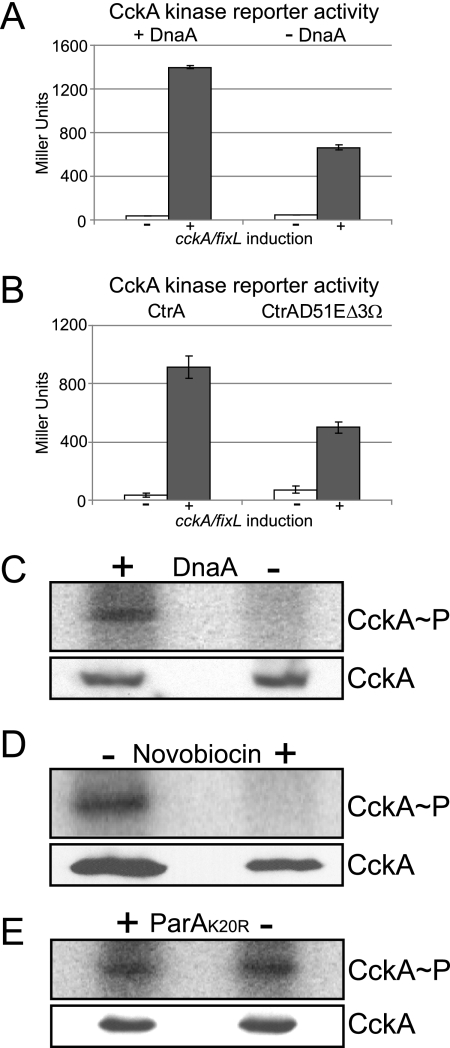FIG. 5.
Initiation of DNA replication is required for CckA phosphorylation and activity. (A) CckA-FixL chimera kinase reporter activity (20) in strain AA1000 incubated in the presence or absence of DnaA. A culture of strain AA1000 was incubated in the presence of vanillate (to induce dnaA) and then washed to remove the vanillate inducer. Two aliquots of the washed culture were grown in the presence of 0.3% xylose to induce cckA-fixL (one with newly added vanillate [presence of DnaA] and the other with no vanillate [absence of DnaA]) and then assayed for β-galactosidase activity after 6 h. The results of control experiments without cckA-fixL induction (no xylose) are shown. (B) CckA-FixL kinase reporter activity assays in strains overexpressing ctrA (strain NJH545) or ctrA(D51E)Δ3Ω (strain NJH544). Cells were grown in the presence of vanillate [to induce the expression of ctrA or ctrA(D51E)Δ3Ω] for 4 h before inducing the expression of cckA-fixL with 0.3% xylose and then assayed for β-galactosidase activity after 6 h of incubation. The results of control experiments without cckA-fixL induction (no xylose) are shown. (C) PhosphorImager results of in vivo phosphorylation of CckA performed with cultures of a DnaA depletion strain (strain GM2471), in the presence of DnaA or depletion of DnaA, using antibodies to CckA (upper panel). Corresponding CckA immunoblots are shown in the lower panel. Synchronized swarmer cells were grown without or with 0.3% xylose (for dnaA induction) for 90 min prior to the in vivo phosphorylation assay. (D) In vivo phosphorylation assay using anti-CckA antibodies performed with the wild-type strain (strain CB15N) in the absence or in the presence of novobiocin (100 μg/ml). Synchronized swarmer cells were grown for 90 min with or without novobiocin prior to the in vivo phosphorylation assay (upper panel) and CckA immunoblot analysis (lower panel). (E) In vivo phosphorylation assay using anti-CckA antibodies performed with the parA(K20R) expression strain (strain ET227) in the absence or in the presence of ParA(K20R). Cultures of ET227 were grown in the absence or presence of 0.03% xylose [to induce parA(K20R)-mCherry] for 1 h. Swarmer cells were then isolated and incubated for 90 min in the absence or presence of 0.03% xylose. The CckA in vivo phosphorylation assay (upper panel) and immunoblot analysis (lower panel) were carried out for each culture.

